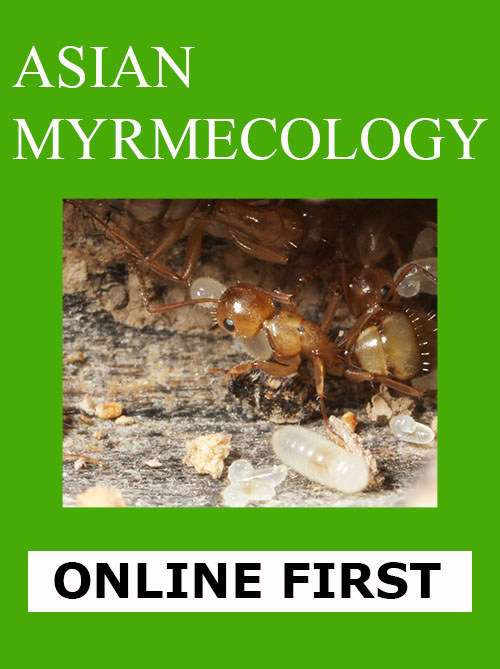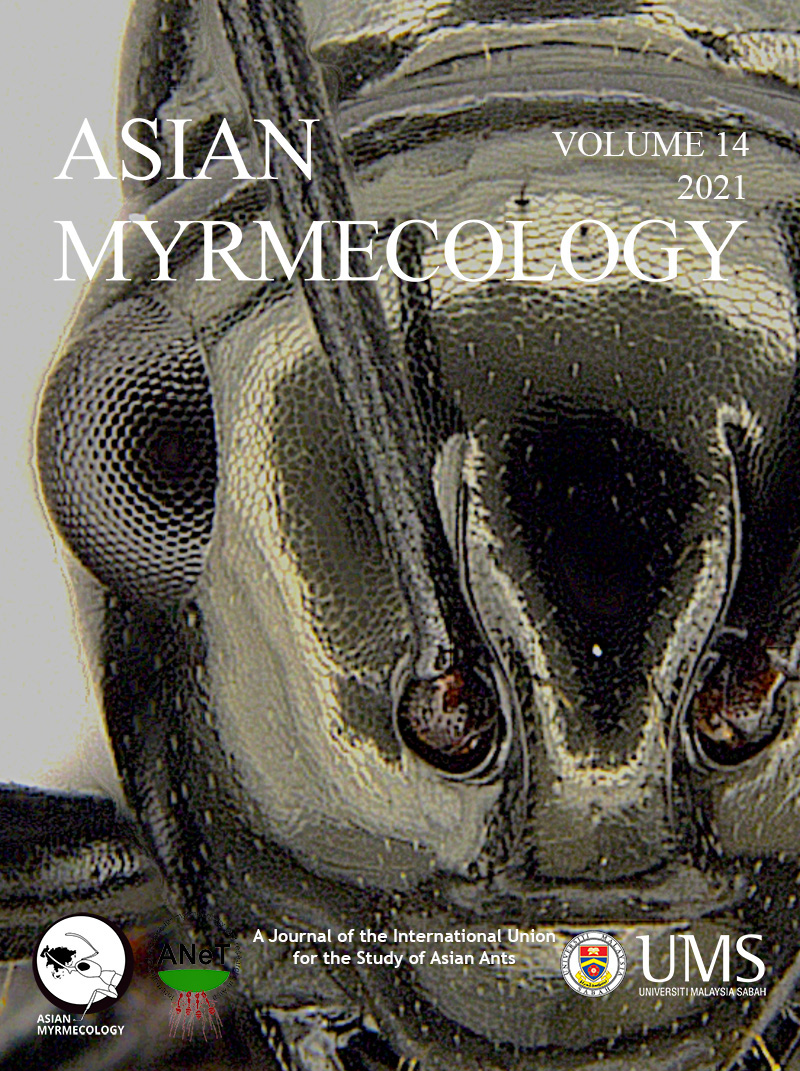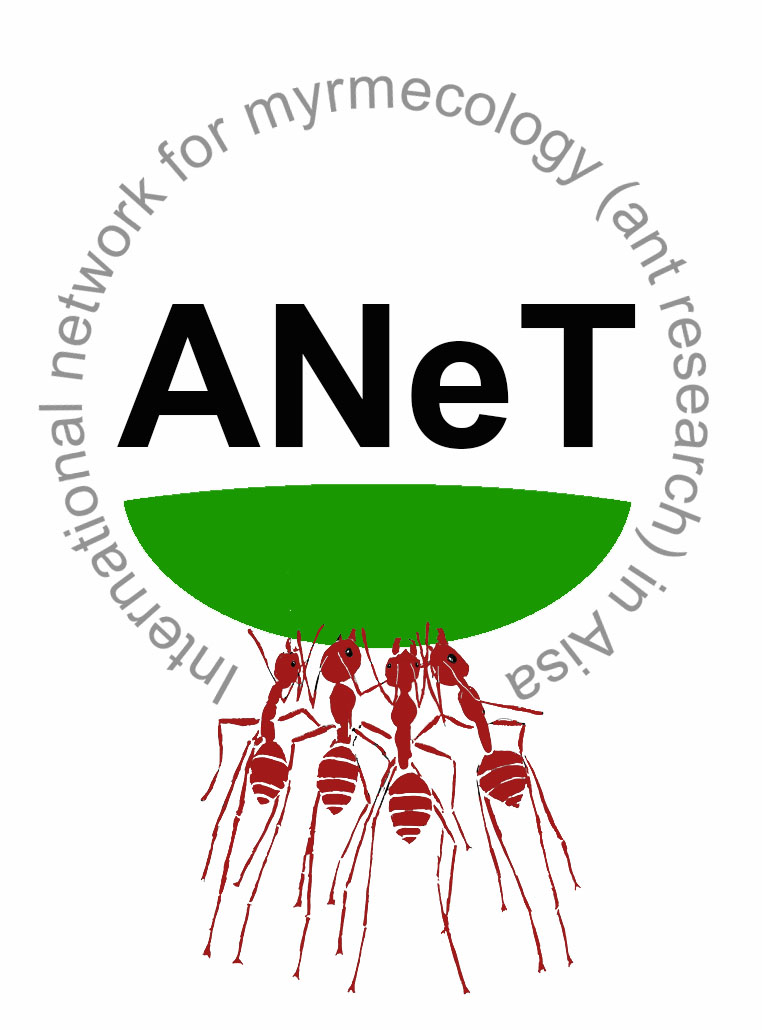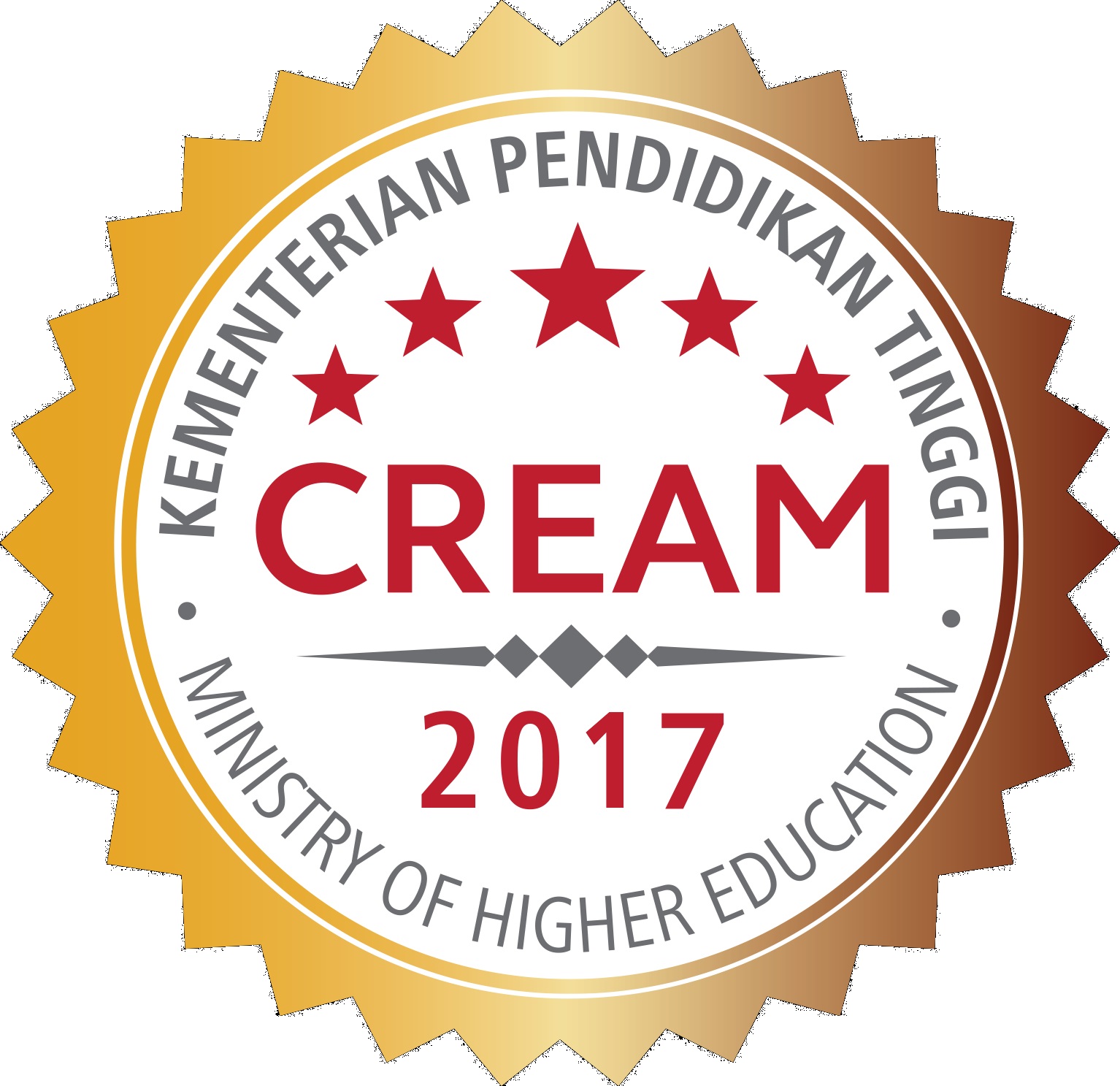ASIAN
MYRMECOLOGY
DOI: 10.20362/am.015006
Asian Myrmecology 15: 015006 (1-152)
article first published online: 14/July/2022
Remarkable diversity in a little red dot: a comprehensive checklist of known ant species in Singapore (Hymenoptera: Formicidae) with notes on ecology and taxonomy
WENDY Y. WANG1, EUNICE J.Y. SOH2, GORDON W.J. YONG2, MARK K.L. WONG3, BENOIT GUÉNARD4, EVAN P. ECONOMO5,6 & SEIKI YAMANE7
Abstract:
Despite a legacy of extensive deforestation, the 720 km2 city state of Singapore still harbours impressively diverse flora and fauna. Given increasing evidence of global insect declines, we urgently need to better document and protect local insect diversity. Numerous species of ants (Hymenoptera, Formicidae) have been recorded or described from Singapore since its founding in 1819. However, it has been over a century since Hugo Viehmeyer (1916) documented a total of 159 species found in the country. Here, we present an updated comprehensive checklist of all named species and subspecies of ants found in Singapore, with specimen collection data, and notes on taxonomy and ecology in the local context. We compiled the list based on museum collections material (the Zoological Reference Collection), primary literature sources, and verified records from known overseas repositories. We documented a total of 409 nominal species and subspecies, also a few notable morphospecies, from 10 subfamilies and 100 genera. These include new records for 121 species and 10 genera. Another 96 species and subspecies have types designated from Singapore; of these, 34 are currently considered as endemic. We also raised nine subspecies to species and synonymized two species, providing reasons justifying each status change: 1) Camponotus (Tanaemyrmex) carinifer stat. n., 2) Camponotus (Tanaemyrmex) tinctus nom rev., 3) Paraparatrechina malaccana stat. n., 4) Aphaenogaster simulans Forel, 1915 stat. n., 5) Myrmicaria adpressipilosa stat. n., 6) Vollenhovia minuta stat. n., 7) Vollenhovia brevicornis (Emery, 1893) = V. fridae Forel, 1913 syn. n., 8) Hypoponera javana stat. n., 9) Hypoponera singaporensis stat. n., 10) Mesoponera javana stat. n. Most species are considered native to Indomalaya, including 13 cosmopolitan tramps. Only 10 other species are presumed exotic to the region. At the time of writing, Singapore can be deemed the city with the highest recorded ant diversity in the world. Despite the sheer numbers, this list remains incomplete, with more species awaiting discovery or taxonomic resolution in future. The immense diversity of ants in Singapore is mainly threatened by continued decimation of remnant forest habitats and encroaching urban developments.
Keywords:
Southeast Asia, biodiversity, natural history, museum collections
Get PDF (1.6 MB) :
WENDY Y. WANG1, EUNICE J.Y. SOH2, GORDON W.J. YONG2, MARK K.L. WONG3, BENOIT GUÉNARD4, EVAN P. ECONOMO5,6 & SEIKI YAMANE7
Abstract:
Despite a legacy of extensive deforestation, the 720 km2 city state of Singapore still harbours impressively diverse flora and fauna. Given increasing evidence of global insect declines, we urgently need to better document and protect local insect diversity. Numerous species of ants (Hymenoptera, Formicidae) have been recorded or described from Singapore since its founding in 1819. However, it has been over a century since Hugo Viehmeyer (1916) documented a total of 159 species found in the country. Here, we present an updated comprehensive checklist of all named species and subspecies of ants found in Singapore, with specimen collection data, and notes on taxonomy and ecology in the local context. We compiled the list based on museum collections material (the Zoological Reference Collection), primary literature sources, and verified records from known overseas repositories. We documented a total of 409 nominal species and subspecies, also a few notable morphospecies, from 10 subfamilies and 100 genera. These include new records for 121 species and 10 genera. Another 96 species and subspecies have types designated from Singapore; of these, 34 are currently considered as endemic. We also raised nine subspecies to species and synonymized two species, providing reasons justifying each status change: 1) Camponotus (Tanaemyrmex) carinifer stat. n., 2) Camponotus (Tanaemyrmex) tinctus nom rev., 3) Paraparatrechina malaccana stat. n., 4) Aphaenogaster simulans Forel, 1915 stat. n., 5) Myrmicaria adpressipilosa stat. n., 6) Vollenhovia minuta stat. n., 7) Vollenhovia brevicornis (Emery, 1893) = V. fridae Forel, 1913 syn. n., 8) Hypoponera javana stat. n., 9) Hypoponera singaporensis stat. n., 10) Mesoponera javana stat. n. Most species are considered native to Indomalaya, including 13 cosmopolitan tramps. Only 10 other species are presumed exotic to the region. At the time of writing, Singapore can be deemed the city with the highest recorded ant diversity in the world. Despite the sheer numbers, this list remains incomplete, with more species awaiting discovery or taxonomic resolution in future. The immense diversity of ants in Singapore is mainly threatened by continued decimation of remnant forest habitats and encroaching urban developments.
Keywords:
Southeast Asia, biodiversity, natural history, museum collections
Get PDF (1.6 MB) :
1Lee Kong Chian Natural History Museum, National University of Singapore, 2 Conservatory Drive, Singapore 117377
2Department of Biological Sciences, National University of Singapore, 16 Science Drive 4, Singapore, 117558
3School of Biological Sciences, The University of Western Australia, Crawley WA 6009, Australia
4School of Biological Sciences, The University of Hong Kong, Kadoorie Biological Sciences Building, Pok Fu Lam Road, Hong Kong SAR, China
5Biodiversity and Biocomplexity Unit, Okinawa Institute of Science and Technology Graduate University, 1919-1 Tancha, Onna-son, Kunigami-gun, Okinawa, 904-0495, Japan
6Radcliffe Institute for Advanced Study, Harvard Univesity, Cambridge, MA USA 02138
7Haruyama-cho, Kagoshima, 899-2704, Japan
*Corresponding author: wywang24@gmail.com



